A content audit is a powerful way to evaluate your existing content, identify gaps, and improve your overall content strategy. Whether you’re looking to boost SEO, enhance user engagement, or align your content with business goals, a thorough audit is essential. In this guide, we’ll walk you through the step-by-step process of conducting a content audit effectively while maintaining a professional tone and ensuring high readability.
Table of Contents
ToggleWhy a Content Audit Matters
Content audits help you assess the performance of your existing material, ensuring it aligns with your marketing objectives. Over time, some content may become outdated, irrelevant, or underperforming. By auditing your content, you can determine what’s working, what needs improvement, and what should be removed or repurposed. This process not only enhances SEO but also ensures your audience receives valuable, up-to-date information.
Step 1: Define Your Goals
Before diving into the audit, clarify what you want to achieve. Are you looking to improve SEO rankings, increase conversions, or enhance readability? Your goals will shape the metrics you focus on. For instance, if SEO is a priority, you’ll analyze keyword performance and backlinks. If engagement is key, you’ll examine bounce rates and time on page. Setting clear objectives ensures your audit remains structured and actionable.
Step 2: Take Inventory of Your Content
Begin by compiling a list of all your content pieces—blog posts, landing pages, videos, and infographics. Tools like Screaming Frog, Google Analytics, or a simple spreadsheet can help organize this data. Include details such as URLs, publish dates, word count, meta descriptions, and performance metrics. A comprehensive inventory provides a clear starting point for evaluation.
Step 3: Analyze Performance Metrics
Once you’ve cataloged your content, assess its performance. Key metrics to review include:
Traffic: How many visitors does each piece attract?
Engagement: What’s the average time on page and bounce rate?
Conversions: Is the content driving leads or sales?
Backlinks: How many external sites link to it?
Low-performing content may need optimization, while high-performing pieces can be repurposed or expanded.
Step 4: Evaluate Content Quality and Relevance
High traffic doesn’t always mean high quality. Assess whether your content is accurate, well-structured, and relevant to your audience. Check for outdated statistics, broken links, or redundant information. Additionally, ensure the tone aligns with your brand voice and that readability scores are optimal. Tools like Hemingway Editor or Yoast SEO can help refine clarity and engagement.
Step 5: Identify Gaps and Opportunities
Compare your content against competitors and industry trends. Are there topics you haven’t covered that your audience is searching for? Use keyword research tools like Ahrefs or SEMrush to discover untapped opportunities. Filling these gaps can position your brand as an authority and attract more organic traffic.
Step 6: Develop an Action Plan
Based on your findings, categorize content into:
Keep as-is: High-performing, relevant pieces.
Update/Refresh: Good potential but needs minor improvements.
Merge/Repurpose: Similar topics that can be combined or turned into new formats.
Remove: Outdated or underperforming content that no longer adds value.
Create a timeline for implementing changes, prioritizing high-impact updates first.
Step 7: Monitor and Iterate
A content audit isn’t a one-time task. Regularly review performance and adjust your strategy accordingly. Set up monthly or quarterly check-ins to ensure your content remains aligned with business goals and audience needs.
Conclusion
A well-executed content audit enhances your digital strategy, improves SEO, and ensures your content delivers maximum value. By following these steps, you can refine your approach, eliminate inefficiencies, and create a stronger content foundation.
Need expert help with your content strategy? Wrebb Digital Solutions offers tailored content audits and optimization services to elevate your brand’s online presence. Contact us today!
FAQs About Content Audits
1. How often should I conduct a content audit?
The frequency depends on your content volume and business goals. For most businesses, a quarterly audit is ideal. However, if you publish content frequently, a monthly review may be necessary to stay on top of performance trends and industry changes.
2. What tools can help with a content audit?
Several tools streamline the auditing process. Google Analytics tracks traffic and engagement, while SEMrush and Ahrefs provide SEO insights. Screaming Frog helps with technical audits, and Hemingway Editor improves readability. Choose tools based on your specific needs.
3. Should I delete or update underperforming content?
Deletion should be a last resort. First, consider updating outdated information, improving readability, or adding new keywords. If a piece is irrelevant or duplicates other content, redirecting or merging it may be a better option than outright deletion.
4. How does a content audit improve SEO?
By identifying weak spots—such as low-ranking pages, thin content, or broken links—you can optimize them for better search visibility. Updating old posts with fresh data and internal linking also boosts domain authority and user engagement.
5. Can a content audit help with lead generation?
Absolutely! By refining high-intent pages (like product descriptions or blog posts targeting commercial keywords), you can enhance conversions. A well-structured audit ensures your content guides users through the sales funnel effectively.
By following these guidelines, you’ll maximize the impact of your content strategy. For professional assistance, Wrebb Digital Solutions is here to help—reach out today!




